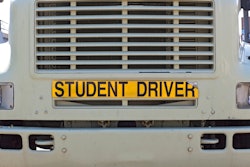The Commercial Vehicle Safety Alliance's (CVSA) North American Roadcheck inspection spree kicks off next month (May 14-16). Inspectors will be on watch for various equipment and driver violations – like brake and tire wear issues, and hours of service – but tractor protection controls in the air system and alcohol and controlled substance possession will get special focus this year.

Roadcheck is coming. Be prepared.
Get YOUR Roadcheck inspection questions answered in this Q&A session — sponsored by Bestpass — with CVSA Roadside Inspection Specialist Jeremy Disbrow on May 1, 2024, at 2 p.m. Eastern.
As such, CVSA's Roadside Inspection Specialist Jeremy Disbrow, who has 21 years of law enforcement experience and plenty of inspections under his belt, told us what exactly inspectors will look for, and how truckers can ace the annual event. Disbrow in two weeks will be a special guest during a live Q&A hosted by CCJ and Bestpass where he will answer questions from the audience. You can register and submit your question here.
Every year, the industry-law enforcement alliance works to come up with two focus areas. This year the consensus, especially on the industry side, Disbrow said, emerged around the FMCSA's Drug and Alcohol Clearinghouse database for positive test results and the tractor protection valve. "Two hot-button issues," as Disbrow described them.
First off, "in the U.S.," he said, "we're seeing a lot of drivers becoming prohibited in that clearinghouse, and a lot of it is because of marijuana use."
He chalked that up to the increasing number of states legalizing marijuana. "We want to raise awareness that if you're using marijuana on weekends or off days, even if it's legal in your state, drivers are still popping positive" during tests required of employers and truck owner-operators, he said.
Anything even cannabis-related should throw up red flags for drivers, as there are a number of well-documented cases of drivers failing drug tests for marijuana without ever using the drug. CBD, a related cannabis- and/or hemp-derived drug that can work well for pain management, sent Sandra Irwin spiraling into a convoluted, difficult "Return to Duty" process, where even following all the steps didn't land her gainful employment right away.
"I'm not always sure that drivers realize that" such products, no matter how legal a gas station or vape shop makes them seem, represent a threat to a CDL career, said Disbrow.
Not only does this year's Roadcheck hope to make that clear to professional truckers, but inspectors, too.
"Inspectors haven’t always had the greatest catch rate, but they're starting to check the Clearinghouse more often," said Disbrow. This year, the goal is to check a driver's CDL in the clearinghouse "on every inspection they do."
Disbrow urged truckers to "remember, you can't have drugs or alcohol in the vehicle, either. That's the other part for the driver." Drivers found with drugs or alcohol, or on the Clearinghouse prohibited-status list, will be placed out of service.
As for the big federal deadline for states to downgrade the CDLs of drivers in prohibited status in the Clearinghouse, which falls on November of this year, Disbrow said most states are already on board, having already downgraded the drivers that tested positive.
Tractor protection valve
The tractor protection valve "allows the tractor to keep a little air in the system" if the tractor and trailer should separate, or the gladhands pop off, Disbrow said. "In the event of a separation of air hose between truck and trailer, the line is obviously going to gush air, but it needs to stop and have a reserve still in the system to allow for safe braking."
The magic number for the amount of reserve is 20 psi "to allow for a safe, controlled brake operation" in the event of a separation. In a pinch, this situation can keep a bad accident from getting worse by allowing the tractor to come to a stop before drifting into a major collision, or blocking freeway traffic at rush hour.
Checking this valve already takes place in the usual 37-step Level I inspection, and that's been the case for years, said Disbrow. Inspectors typically "chock wheels to make sure the vehicle doesn’t go sliding away, release all its brakes, and then pop both gladhands," he said. "We remove both gladhands from truck and trailer and listen to the air escaping. Once it stops, we go back up to cab, and as long as it’s 20 psi or higher," all is well.
If testing that valve isn't part of your pre-trip, consider making it one, said Disbrow. But beware lazier approaches to the process.
"A lot of drivers think they’re testing for it," said Disbrow. "What they’ll do is pump down brakes, and wait for dash valve to pop out. But that's not really the same thing."












